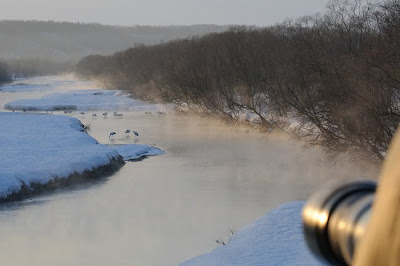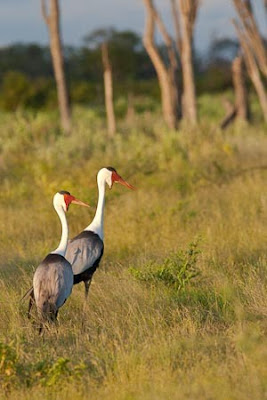It’s funny the looks you get when you tell people you are going to Japan to photograph their wildlife. What most people don’t realise is that Japan houses some very unique and highly endangered wildlife, that allow for some very close up and personal wildlife photography. So while it may not be high on animal diversity (what sub zero winter destination is?) it is high on uniqueness of species with which we spent a lot of time photographing..
After meeting and spending the night in Tokyo, we headed straight to the northern most island in the Japanese archipelago (of 3600 islands), Hokkaido.
This large island houses a large farming and fishing community as well as most of the protected wildlife in Japan- hence us staying 7 nights here!
Leaving Tokyo, the temperature was a balmy 0 C. Arriving in Hokkaido we were greeted to -7C and a fresh wind to drop the thermometer a couple more degrees.
Photographing in sub zero temperatures you need to be well equipped with the correct clothing and also the correct camera equipment. You also need to be dedicated wildlife photographers, which is exactly what our group was, with every one well kitted out with thermal gear. Even jokes were being made about -20 and no thermals!
The first specie we photographed was “Tancho”, the Japanese crane. This bird’s numbers once got as low as 160 birds in Japan. Today their numbers are up to near 2000, and gratefully so. They are one of the most graceful birds in the world. And that is before they do their courtship dance which truly one of the great birding spectacles. Their grace flows from their necks into their wings, feet and upturned bills. Photographing them is quite remarkable. Due to their various feeding and roosting spots, we were able to photograph them in many different habitats. Two real highlights were seeing them at their roosting spot and at an education centre where some come for food.
The cranes roost in the Tsurui River to avoid the freezing ground temperatures.
The goal is to photograph them at dawn as the steam is rising from the river. At temperatures of around -20C the mist from the river attaches to the trees alongside as hoar frost to create a stunningly beautiful scene at sunrise. So there we were in the dark on a bridge, tripods set up waiting for the sun to rise.
We were luck enough to get the right conditions for all the above and we captured some lovely images of the enigmatic Japanese cranes in one of the most beautiful, serene and surreal scenes I’ve had the pleasure to witness.
Photographing the cranes feeding was another highlight. Not only because of the cranes, but also due to he white tailed eagles that stoop down to steal the feed. This causes a lot of interaction and certainly keeps the cameras firing away and warm.
After we left the cranes we headed north to the whooper swans in ice. Nagano Lake is very large and very frozen in late winter, when we visited. Due to the thermal activity of the island, some to water springs leak into the lake, melting the ice and warming the water. This attracts the swans who come for a warm bath. It also allows for some very moody images with the steam rising from the water. We spent 4 sessions photographing these swans in every angle imagineable. What with the white feathers on the white snowy background, I believe we could have all spent 4 more sessions working with these very beautiful subjects.
Rausu is a fishing town that lives on the extreme edge of life. Deep snow on one side and pack ice on the other surround the harbour in winter. The wildlife here is also very extreme. Orcas, brown bears, sea lions and shearwaters in Summer and the endangered Stellars sea eagle in Winter.
These striking eagles are really a sight to behold. Very different to many other birds of prey, they dominate the ice floes around Rausu.
We spent two mornings on a chartered boat with these eagles. This enabled us to see them in different light conditions and even with snow! The eagles were a real highlight for our groups and in our spare time we even cruised the town in search of them perched in the trees!
From Rausu it was back to the mainland via Tokyo and up towards Nagano for the Japanese maquaces. These intelligent monkeys have developed, over a hundred years or so, a knack for the warm steam baths that were originally built for humans. What it has resulted in are some beautiful scenes of the pink-faced maquaces in steaming water- creating a very lovely mood. And one which we took full advantage of! It was a full day of photography and by the time we had to leave, everyone was absolutely exhausted after running after the very active monkeys all day!
From Nagano we headed back to Tokyo where we indulged in some Japanese culture. This was unfortunately the end of another C4 Images and Safaris photo tour. It was also the first of our international tours. We hope to expand this aspect of C4 Images and Safaris in the future.
Many thanks to Go Yamagata who made the tour possible through his organisation and logistics in Japan. I wish to thank the dedicated photographers Paul, Pamela, Sheila, Geoff, Chris and Alan for joining us to this excellent wildlife photography destination.
Read more...
Wednesday, March 24, 2010
Tuesday, March 16, 2010
Trip Report, Stanley's Camp, Okavango Delta
By Isak Pretorius
When you go to a place where there are abundant wildlife, water and sunshine mixed together, you are guaranteed to see something spectacular! The Okavango Delta is such a place, a pure wilderness and probably the most exciting game viewing destination in Southern Africa.C4 Images and Safaris have just concluded a very memorable photographic safari to the Okavango Delta at Stanley's Camp. The camp is situated in the heart of the swamps just below the South Eastern tip of Chiefs Island. They've had extremely good rainfall in the Okavango Delta during January and February. This resulted in unusually high levels of water on the floodplains for this time of the year. The water level was almost as high as when the flood waters push in from the Okavango river during July and August. This meant that we were in for an interesting time ahead! Just as at Chiefs Camp, Stanley's Camp uses game viewing vehicles specifically modified with bigger wheels and raised suspensions to negotiate the swampy terrain effortlessly. I've never seen so much water around and having water rush over the bonnet and over the floor of the vehicle provided an additional thrill for everyone!
The safari was led by Greg du Toit and myself. Drizzling and overcast weather on the first two days meant that we had a slow start to the safari. Luckily we were all serious photographers and this could not damped our spirits. In fact, we were excited to use the elements to our advantage, searching for unique photo opportunities of impala and wildebeest in the rain! We also enjoyed the dramatic skies for which the Okavango Delta is famous. On our second drive, a great sighting of a leopard that entertained us for an entire morning got the shutters working properly.
The next few games drives delivered sightings of elephant, buffalo, giraffe, and letchwe before we were treated to a once-in-a-lifetime sighting of a lion kill. We witnessed a pride of six lions killing a young zebra thanks to Greg du Toit who made the call to stick it out for an afternoon with the lions, watching them sleep, waking up, stalking, ambushing, and finally devouring. A complete cycle rarely seen, and of course stunning photographs by everyone! Oúr vehicle, on the other hand, stumbled onto a few wild dogs staking a herd of impala on our way to the lions. "Spoilt for choice" got a new meaning as we had to choose between following wild dogs on the hunt or lions stalking zebra. We decided to follow the wild dogs for a while but when the call came over the radio that the lions had killed a zebra we quickly rushed to witness the action.
Another memorable sighting we had on our way back to camp one evening was of a spotted hyena walking in the road and in the swampy water looking for a meal. With the dark water at night and subject illuminated only by the spotlight, this made for some dramatic images. During our final game drive of the safari we were luckily to find a big male leopard crossing one of the water channels. I was interesting to see how he very slowly and carefully made his way through the water trying not to make a sound! This is a sight that you'd only find in the Okavango Delta and it ended our safari on a high.
The Okavango Delta is of course also a bird paradise. With most of our guests being keen bird photographers it meant that everyone were in their element! Fish Eagles around every corner, Grey-headed and Striped Kingfisher, Saddle-billed Storks, Wattled Cranes and Dwarf Bittern were a few of the species that got us really excited.
When hosting a photographic safari it is important to go to a camp that can take care of our clients, making them feel at home and relaxed after a hard day of photography out in the African bush. Stanley's Camp is exactly such a camp! It is a very intimate camp gathered around a large sitting and dining area which offers great views over the Okavango Delta floodplains and one of the best camps I've ever been to. Apart from the filter coffee wake-up call, the friendly staff and exquisite food prepared by chef Harry is what made the camp extra special. The camp also offers an elephant interaction experience, mokoro excursions, and guided walks if you want to try something different.
Unfortunately all good things had to come to an end. We were sad to leave but enjoyed the last breath-taking views from the Okavango Delta as we flew back from the camp to Maun where we all went our separate ways. A big thanks to Evelyn, Harry, Jonathan, Carter, and the rest of the staff at Stanley's camp for making it a trip of a lifetime!
Read more...
Subscribe to:
Comments (Atom)



























